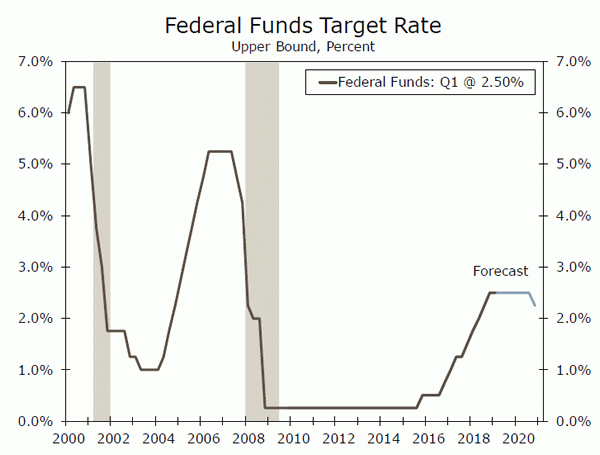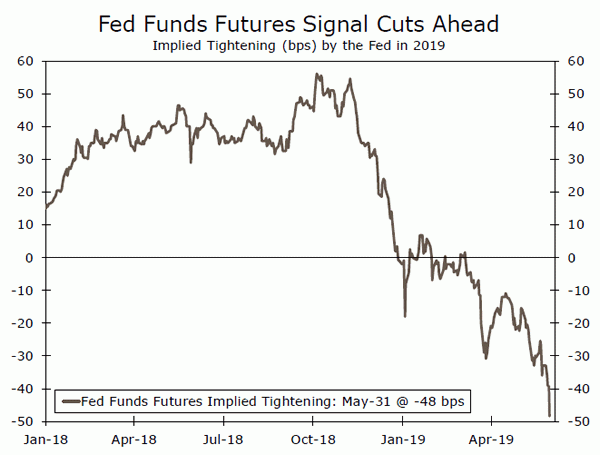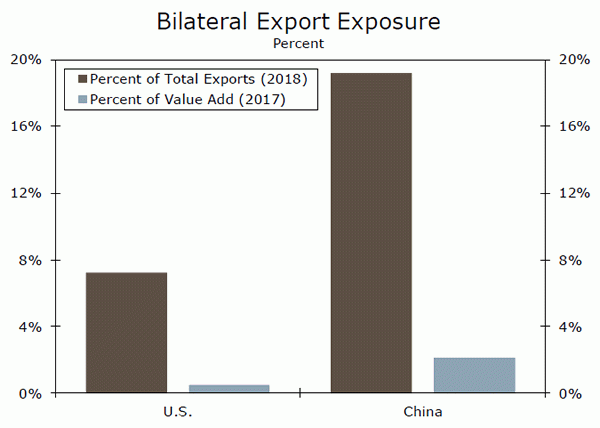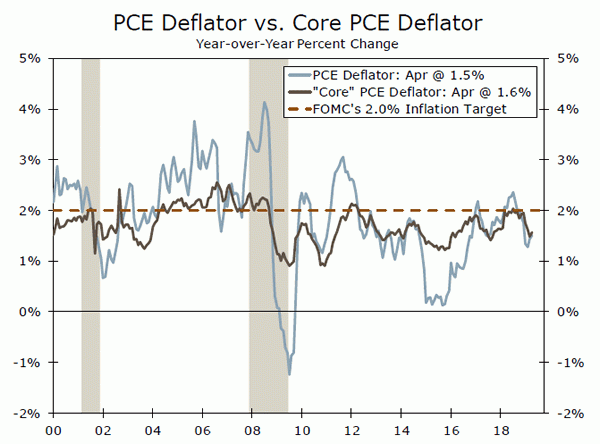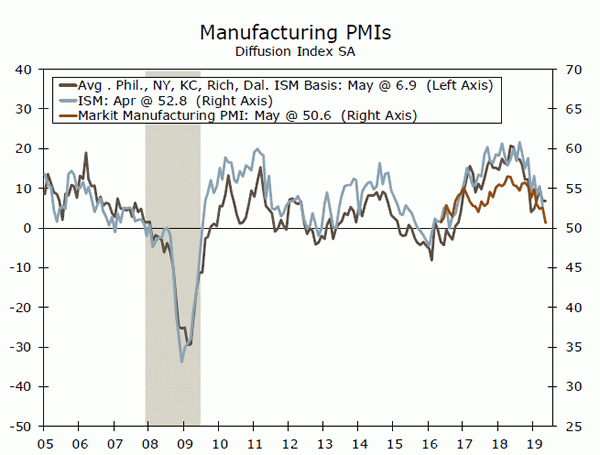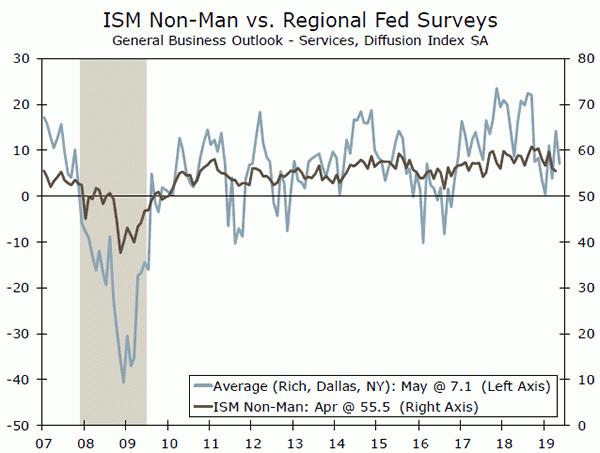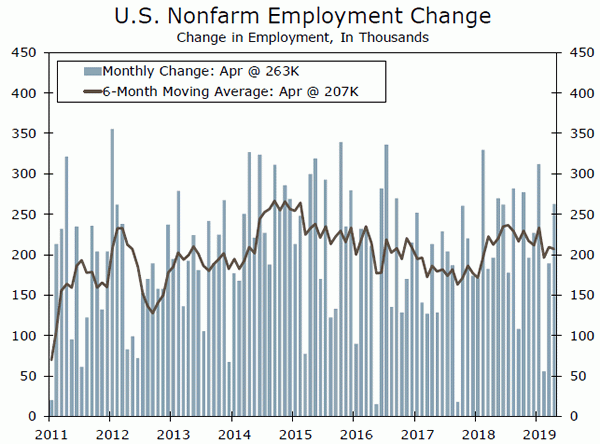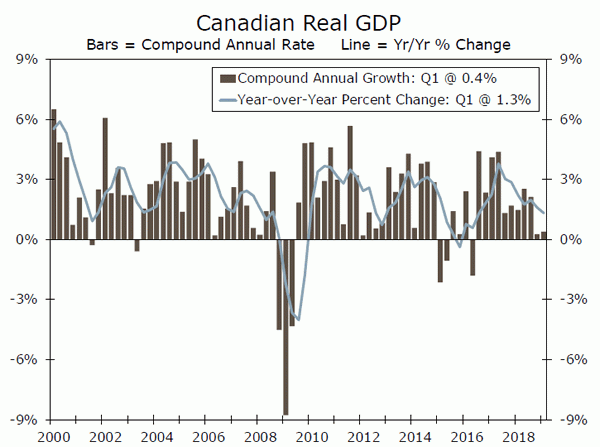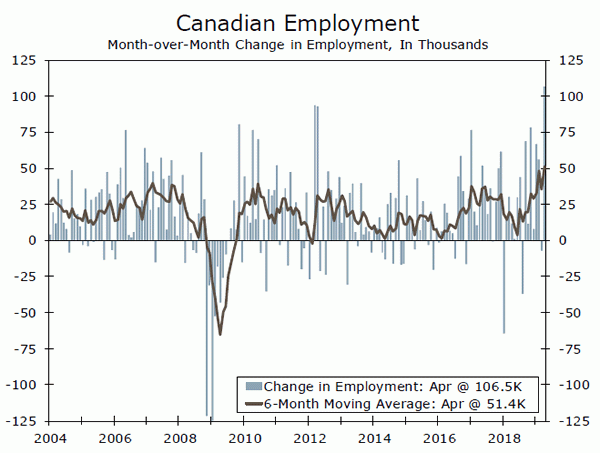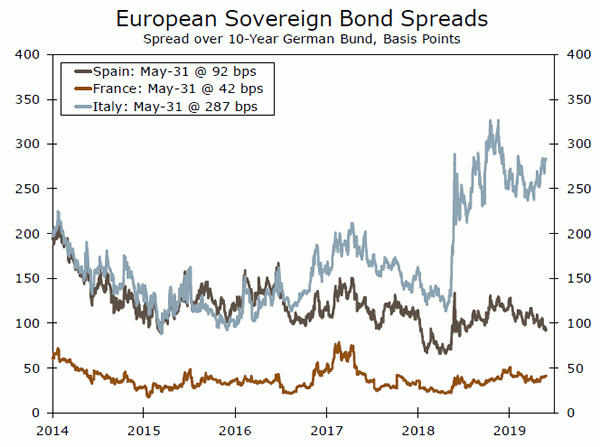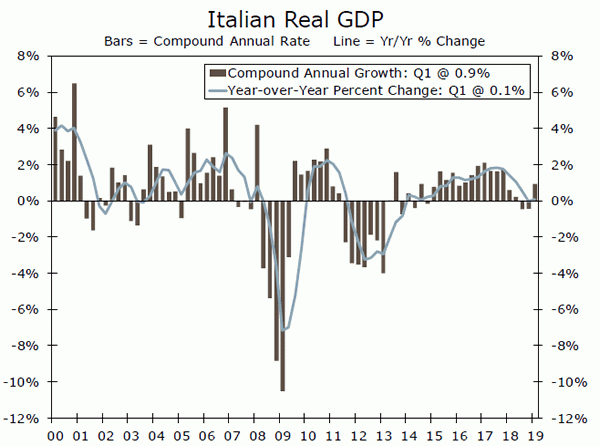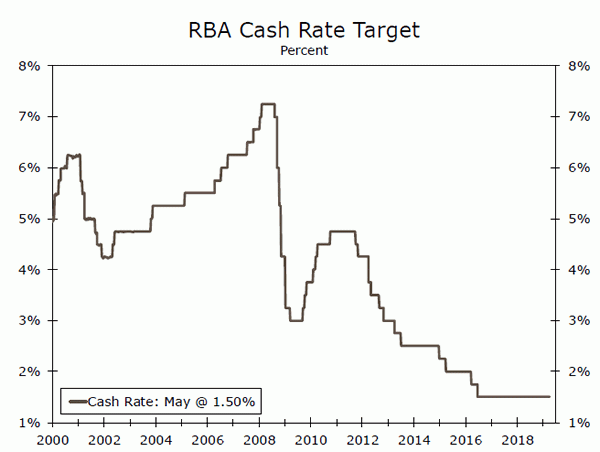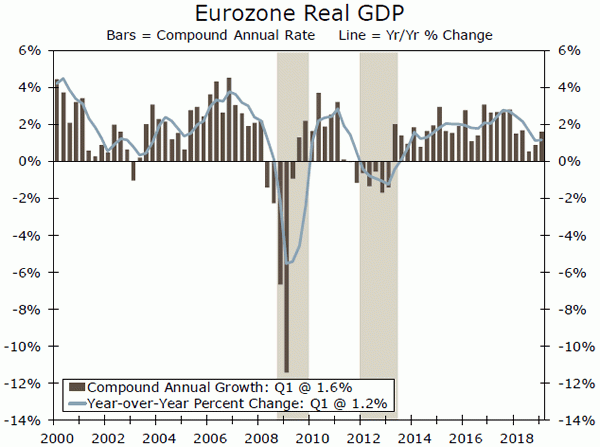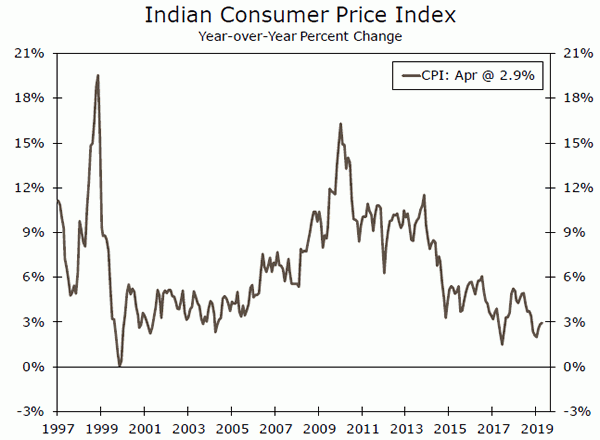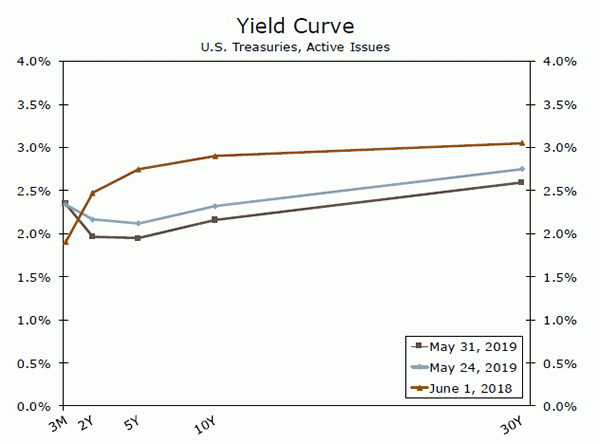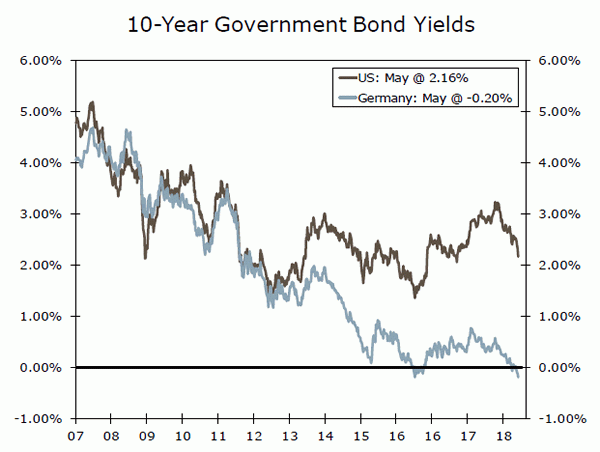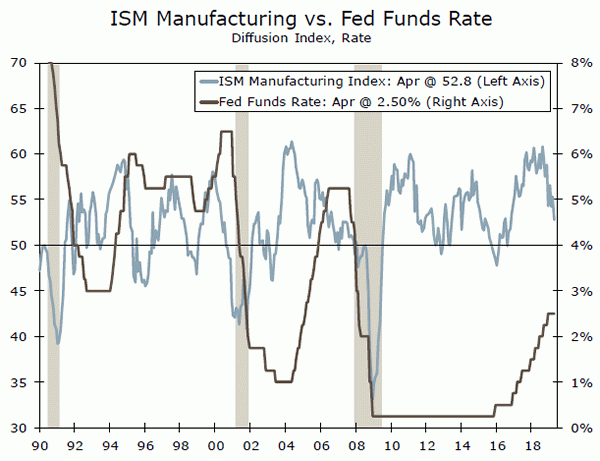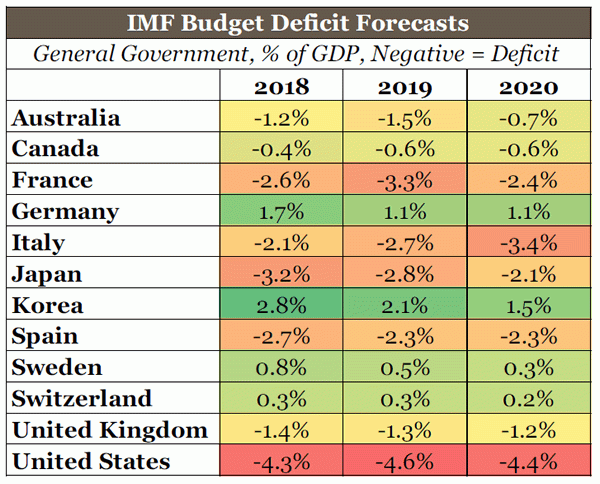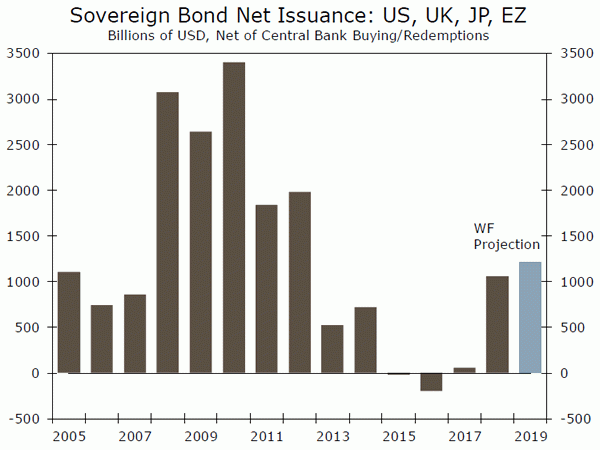U.S. Review
Markets Jitter as Trade War Escalates
- Fear around the trade war remained top of mind for market participants this week, and helped instigate another inversion of the yield curve.
- There is no denying that the yield curve has inverted prior to each of the past six recessions, but we stand by our previously stated deduction that it alone does not necessarily mean we are headed for an impending downturn.
- That said, the trade war remains the largest downside risk to the outlook. Increased tariffs have yet to manifest themselves in steep increases in consumer goods prices, however, the potential is there.
Markets Jitter as Trade War Escalates
Fear around the trade war remained top of mind for market participants this week, and helped instigate another inversion of the yield curve. The yield curve has been flirting with inversion for the past six months, but recent escalation in the trade war has brought fear of an imminent recession back into the fore.
An inversion of the yield curve can signal investor suspicion— about the pace of future growth, or if the Fed will need to cut rates. The escalating trade war has boosted uncertainty about growth, while the market implied probability of a rate cut by year-end continues to rise (top chart). There is no denying that the yield curve has inverted prior to each of the past seven recessions, but we stand by our previously stated deduction that it alone does not necessarily mean we are headed for an impending downturn.
That said, the trade war remains the largest downside risk to the outlook. A couple of weeks ago, the Trump administration hiked tariffs to 25% from 10% on an estimated $200 billion of Chinese imports, and threatened to impose the 25% tariff on all remaining goods from China. In response, China announced a hike to tariffs on U.S. imports. While exports to China account for less than 8% of total U.S. exports (middle chart), the trade war may be beginning to have rippling effects throughout the economy.
Even if President Trump’s tariff ‘strategy’ gives way to better relations with our trading partners and tariffs are eventually rolled back, they have already began to affect corporate supply chains and are expected to weigh on profits this year. At the end of the day, remember tariffs are taxes. They tend to raise the price of imported goods for U.S. consumers and producers, which could cause prices of domestic goods that compete with these imports to rise.
Increased tariffs have yet to manifest themselves in steep increases in consumer goods prices, however. At 1.6% on a year-over-year basis in April, core PCE inflation remains below the Fed’s target (bottom chart). The core PCE deflator did rise 0.25% in April, which is the largest monthly increase since October 2017, and perhaps provides support to Chair Powell’s assertion that the recent soft patch in inflation was temporary. Recall, these figures reflect April prices, before the recent escalation in the trade war, so there may be scope for prices to rise in coming months. The broader impact of tariffs, say via investment decisions, is more difficult to quantify. This morning President Trump threatened a 5% tariff on Mexican imports (quoted to start on June 10), to combat illegal migration. With little sign of a resolution to the escalating—and expanding—trade war, growth expectations will likely trend lower in coming months.
The trade skirmish is escalating just as many economists had expected the economy to slow from the first quarter’s artificially high headline number of 3.1%. Indeed, first quarter final domestic demand growth was the weakest it has been in nearly six years. With trade risks becoming increasingly important to the outlook and inflation remaining comfortably south of the Fed’s 2% target, the Fed may need less of a reason to move from its patient stance, and cut rates earlier than currently expected.
U.S. Outlook
ISM Manufacturing • Monday
Markets will be watching the ISM manufacturing index more closely than usual on Monday. Last week the preliminary Markit PMI fell to a nine-year low, sparking fears that the recent escalation in trade tensions with China is snuffing out the expansion. Other purchasing managers’ indices have held up better, however. An ISM-equivalent average of the regional Fed PMIs signals the pace of manufacturing output was little changed last month. We expect the ISM index to signal a further slowdown in factory activity in May, but to remain in expansion territory.
An unexpectedly weak reading would pile on to the market’s recent concerns about growth in light of the latest trade developments. However, with manufacturing accounting for only 12% of U.S. output, it would take a severe drop in the index for the Fed to push aside its patient stance and cut rates.
Previous: 52.8 Wells Fargo: 52.1 Consensus: 53.0
ISM Non-Manufacturing • Wednesday
Given that the ISM non-manufacturing index reflects the remaining 88% of the U.S. economy, Wednesday’s ISM release will be more telling about the state of growth. Similar to its manufacturing counterpart, the preliminary read of the Markit service sector PMI fell in May and added to concerns about U.S. growth continuing to slow. Service-sector surveys from the regional Federal Reserve banks also showed activity slowed in May, albeit from an eight-month high in April. We therefore look for the ISM non-manufacturing index to be little changed for May.
A downside miss would signal that the slowdown in growth extends beyond the external-facing parts of the economy most exposed to trade. Fed officials, however, were already expecting growth to moderate this year as fiscal stimulus fades. As long as the non-manufacturing index stays around the mid-50s, we would not expect it to shift the Fed’s near-term policy stance.
Previous: 55.5 Wells Fargo: 55.4 Consensus:55.7
Employment • Friday
Hiring likely cooled in May after a surprisingly strong gain of 263,000 jobs in April. We expect payroll growth to slow in May but, at 180,000, to remain close to its recent trend. Initial jobless claims have moved up since April, but are on par with their average since the start of the year. Given recent swings in the labor force, we expect the unemployment rate to rise to 3.7%, while average hourly earnings should rise 0.3%.
The quick escalation in the trade war this month was unlikely to have affected the employment numbers, which were based on employment in the middle of the month. Another solid read on hiring would therefore signal to the FOMC that the labor market was humming along ahead of recent concerns. A marked miss to the downside, on the other hand, would suggest that the growth outlook was already cooling, and potentially pull forward expectations of the FOMC adjusting policy with a rate cut.
Previous: 263K Wells Fargo: 180K Consensus: 185K
Global Review
Bank of Canada Upbeat, Italy Stirs the Pot
- Despite another soft GDP print, policymakers at the Bank of Canada expressed optimism this week that the slowdown in growth in late 2018/early 2019 will prove to be temporary.
- Italian sovereign bond spreads crept higher this week as concerns about Italy’s fiscal outlook returned to the headlines.
- The European Commission projects that under current policy the Italian budget deficit will rise to 3.5% in 2020, a clear violation of the bloc’s rules. If Deputy Prime Minister Matteo Salvini has his way and enacts a flat tax, the deficit may be even larger, potentially setting up another fiscal showdown between Brussels and Rome this fall.
Bank of Canada Upbeat, Italy Stirs the Pot
The Bank of Canada (BoC) met this week, and like many of the world’s central banks was forced to reckon with the slowdown in global growth over the past few quarters. Data released this morning showed the Canadian economy growing at just 0.4% on an annualized basis in Q1, the second consecutive sub-1% reading (see chart on page one). Despite the soft print, the BoC adopted a relatively upbeat tone, noting in its statement that “recent data have reinforced the Governing Council’s view that the slowdown in late 2018 and early 2019 was temporary.” The BoC pointed to a recovery in the oil sector and housing market indicators that point to a “more stable national market, albeit with continued weakness in some regions.”
Another recent bright spot has been the robust Canadian labor market. Canadian payrolls rose nearly 107,000 in April, the largest gain on record. While some of the recent strength can be attributed to a jump in part-time employment, full-time employment in Canada is up 1.6% over the past year, even better than the 1.3% pace in the United States. At present, financial markets are only pricing in 25 bps of easing by the BoC over the next twelve months, compared to 69 bps in the United States. We expect the BoC to be on hold through the end of the year, but think the BoC may start to hike again early in 2020.
Italian sovereign bond spreads over German bunds continued to creep higher this week as concerns about Italy’s fiscal outlook returned to the headlines (middle chart). After all of the hand wringing last fall, Italy’s budget deficit for 2019 is projected to be 2.5%, up only a bit from 2.1% in 2018. Given in part how much the Italian economy has slowed over the past few quarters (bottom chart), Italy has managed to avoid any financial penalties from the European Union for this fiscal slippage. As 2020 comes into focus, however, the European Commission (EC) this week expressed concern over the fiscal outlook. Despite forecasting faster growth and inflation in Italy next year, the EC projects that the budget deficit will widen to 3.5%, a clear violation of European Union rules.
Italy introduced a citizens’ income and some more generous pension provisions earlier this year that are already baked into the aforementioned EC projections. However, additional fiscal easing may still be around the corner. Deputy Prime Minister Matteo Salvini, emboldened by his party’s strong showing in the European Parliament elections, has continued to push for fiscal and economic reforms that include, among other things, a flat tax that would likely widen the deficit even further.
If Salvini can push through tax cuts of some sort, the clash between Rome and Brussels could be similar to or even worse than the one that occurred in the second half of last year. The conflict would likely ramp up in September/October, when Italy will have to draft and submit a budget plan to European Union officials. If the coalition between Salvini’s party (“Lega”) and the Five Star Movement falls apart in the coming months, Italy could have national elections later this year for the second year in a row.
Global Outlook
Reserve Bank of Australia • Tuesday
The Reserve Bank of Australia (RBA) will meet next Tuesday and evaluate whether conditions have evolved such that the first rate cut since 2016 is warranted. Q1-2019 real GDP growth in Australia will be released the same day and could show economic growth slowing to below 2% on a year-over-year basis. Australia’s economic linkages to China are relatively high compared to most other developed economies, and the slowdown in China has likely contributed to some of the weakness in Australia.
Like Canada, the Australian housing market is currently going through a soft patch and inflation has remained subdued, up about 1.5% through the first quarter. Against this backdrop, financial markets are pricing in roughly 68 bps of easing by the RBA over the next 12 months. Given that the U.S.-China trade spat has only worsened since the last RBA meeting, it would not surprise us if the RBA cuts its main policy rate 25 bps next week.
Previous: 1.50% Consensus: 1.25%
European Central Bank • Thursday
Monetary policymakers in Europe will meet next week to discuss the ailing Eurozone economy. Real GDP growth was a bit stronger in Q1, but it still registered an anemic 1.2% year-over-year. The data thus far in the second quarter suggest that the economy is continuing to tread water around this pace. The Markit Eurozone composite PMI was 51.6 in May, up 0.1 from April and flat from March. The May manufacturing PMI, at 47.7, remained in contractionary territory.
The European Central Bank (ECB) will announce the parameters for its targeted longer-term refinancing operations (TLTROs) next week, but past that our expectation is for the central bank to more or less maintain its wait and see approach. The economy has not weakened enough to warrant a full reversal into an easing cycle, but it remains a ways off from the first rate hike. Our expectation is for the ECB’s policy rates to remain on hold for the remainder of the year, but gradually exit negative territory in 2020.
Previous: -0.40% Wells Fargo: -0.40% Consensus: -0.40% (Deposit Rate)
Reserve Bank of India • Thursday
In the wake of Prime Minister Narendra Modi’s reelection, the Reserve Bank of India (RBI) will meet next Thursday. Data on real GDP growth in India were released this morning and showed the economy expanded 5.8% year-over-year in Q1-2019. Though strong relative to most other major economies at present, this still marked the slowest pace of growth since 2014. Inflation also remains firmly in control; the RBI targets consumer price inflation of 4% within a +/- 2% range, and price growth is currently running at about 3%.
Slower growth and inflation have prompted some to speculate that the RBI might cut interest rates at an upcoming meeting. Financial markets appear to be pricing in about 39 bps of easing over the next 12 months. The RBI has already cut rates 50 bps this year, and with some of the uncertainty in the economy likely easing post-election, it looks like a close call whether the RBI will keep easing or wait to see how the economy reacts to previous rate cuts.
Previous: 5.75% Consensus: 5.50% (Reverse Repo Rate)
Point of View
Interest Rate Watch
Inverted For Real
For all the talk about how this time is different, the recent inversion of the yield curve appears to have all of the characteristics of past inversions. The yield curve is an indication of bond investors’ views of future economic conditions, and those views have been downgraded considerably after trade negotiations with China took a bearish turn earlier this month. The key take-away from the negative turn in trade talks was that China never intended to fulfill any agreement made with the United States and finally balked when U.S. negotiators insisted on including repercussions for non-compliance in any agreement. Global growth is now likely to slow even further and remain slower for longer, which has pulled down long-term rates in Germany and the United States.
The greater influence of slower global economic growth and lower and even negative interest rates overseas is the most cited reason so many folks have been so quick to dismiss the most recent inversion of the yield curve, which has seen the yield on both the 10-year and 2-year Treasury note fall below the federal funds rate. The implicit assumption here is that the bond market is more concerned about the U.S. economy’s long-term and near-term prospects than the Federal Reserve is.
The near-term data look fairly benign. Real consumer spending was unchanged in April, but healthy gains in March put Q2 consumer spending on a pace to rise at a 3% annual rate. Consumer confidence also rebounded solidly and jobless claims remain near their cycle lows. Data from the manufacturing sector are worrisome, with industrial production down year-over-year and orders clearly decelerating. That said, the most recent round of Fed manufacturing surveys was somewhat more positive.
While all this seems reassuring, most of this data reflect activity and sentiment prior to the intensification of trade talks. Even the better news on consumer spending says more about what happened two months ago that what is happening today. Private final demand has clearly lost momentum, leaving the economy more vulnerable to an external shock or policy mistake.
Credit Market Insights
Starts with a Three
The 30-year fixed-rate mortgage rate dropped into the three-range this week for the first time since January 2018. Swirling uncertainty surrounding trade and global growth have sparked a sustained rally in longer-term Treasurys, causing the 10-yearthree- month yield curve to invert this week. The 10-year is currently yielding only 2.2%, the lowest since 2017. Such a steep drop in mortgage rates will likely provide a boost— or at least a floor—to housing in coming months. The domestic housing market is fairly insulated from the issues driving investors into safe assets and could therefore see a slight pickup at the same time overall growth weakens, so long as the growing risk-off attitude on Wall Street doesn’t take a turn onto Main Street. Moreover, the 3.99% rate—down seven bps since just last week—reported by Freddie Mac and highlighted by the media represents a so called “top tier” rate, as it assumes a 20% down payment and otherwise sterling buyer credit. Thus many potential homebuyers may not yet be seeing a three-handle from their bank. Mortgage bankers suggest it may take several weeks of continued strength in the bond market before rates truly push into the three-range for a majority of future homebuyers. Nevertheless, it was only a few quarters ago that the 30-year rate was about to breach 5%. While the spring housing rebound many expected has not quite materialized, the market has certainly stabilized, likely due in large part to lower rates, which should continue to provide support.
Topic of the Week
Do Deficits Still Matter?
The recent widening in the federal budget deficit and persistently low yields on U.S. Treasury securities have led some observers to question the idea that larger deficits lead to higher interest rates, or even if deficits matter at all. Using the International Monetary Fund’s measure of the general government budget deficit, the United States is currently running one of the largest consolidated budget deficits in the developed world (table to right). Can the United States really run large budget deficits indefinitely with minimal consequences?
In our view, yields on Treasury securities have remained low in the face of bigger deficits for both cyclical and structural reasons. On the cyclical side, a dovish turn by the Fed and falling growth/inflation expectations have weighed on yields, dominating the upward pressure from more government debt issuance. Net sovereign bond issuance in other major foreign economies has also been quite low recently, due to both fiscal consolidation and to quantitative easing programs by foreign central banks (bottom chart). These factors probably have contributed to downward pressure on U.S. government bond yields as well. Econometric analysis that attempts to control for factors like these suggests that deficits still exert upward pressure on yields, all else equal.
On the structural side, the United States enjoys many built-in advantages that make financing large deficits easier. The U.S. dollar is the world’s reserve currency, the U.S. economy is the largest in the world and the Treasury market is the gold standard for liquid, safe assets.
Could some of these circumstances change one day, making it much harder to finance structurally large budget deficits? Of course, though when or whether they will is up for debate. In our view, it is not that deficits no longer matter. Rather, favorable circumstances for large-scale sovereign debt issuance exist today, but that does not mean they will exist forever.
For further reading, see our recent special report, “Do Deficits Still Matter?”




